[vc_row el_id=»faq»][vc_column][/vc_column][/vc_row][vc_row][vc_column][vc_accordion active_tab=»1″ title=»Facts about Russia»][vc_accordion_tab title=»Maslenitsa»][vc_column_text]
Maslenitsa is an Eastern Slavic folk holiday in Russia, celebrated during the week before the Russian Orthodox Lent. It has pagan roots and it was dedicated to end of winter and the beginning of spring. Traditional cuisine of Maslenitsa is bliny (pancakes). They are round and golden, which symbolize sun. Consequently, Maslenitsa is also known as Pancake Week or Butter Week.
Like Mardi Gras, Maslenitsa is the last chance to have fun before Lent.
Each day during the Maslenitsa week has its own meaning.
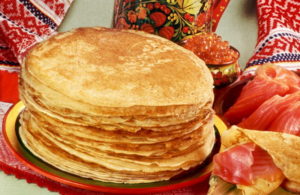
Monday – Greeting
On the first day of Maslenitsa there are family visits. Daughters-in-law visit their parents, and mothers- and fathers-in-law join them in the evening. It is the day when Lady Maslenitsa is made of straw and old clothes.
Tuesday – Matchmaking / Playing
During that day gentlemen are invited to the lady`s houses to eat pancakes and enjoy sledging. Men may choose a bride and marry after Lent.
Wednesday – Sweet Day
On Wednesday the son-in-law may visit their mother-in-law who prepared pancakes and invited other guests for a party. The mother-in-law should show her love and care to the her daughter`s husband.
Thursday – Revelry
It is the day when all the work stops and celebrations start widely. Thursday may be devoted to outdoor activities. The idea of the day is to let go of all the negative feelings, gained during the cold winter evenings. People enjoy snowball fights, fist fighting, sledding, ice-skating and horse-riding.
Celebrations are followed by building a fire; people jump over the fire and sing songs.
Friday – Mother-in-law evenings
It is the evening when mother-in-law visits her daughter`s house and eat her pancakes.
Saturday – Sister-in-law time
It is the day when young brides would invite sisters and other relatives of their grooms. The bride should give a present to her sister-in-law.
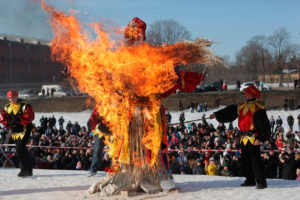
Forgiving Sunday
This day is the end of fun and games. People ice slide, make fires to melt the ice, ask for forgiveness. Everybody asks each other for forgiveness, bowing at his feet. As the culmination of the celebration people burn Lady Maslenitsa, representing winter, to accelerate the spring coming.
The day following the Sunday of Forgiveness is called Clean Monday, because people have confessed their sins, asked forgiveness, and begin Lent with a clean conscience.[/vc_column_text][/vc_accordion_tab][vc_accordion_tab title=»Kommunalka — communal apartment»][vc_column_text]
Communal apartments came into after the October revolution, when Bolsheviks confiscated private property. Housing shortages were a big problem and the Soviet government solved it in this way: big expensive apartments, previously owned by well-off families, would be divided for people in need.
Communal apartments brought together completely different people. For example, a professor would share space with a cook or a revolutionary soldier. Many noteworthy Russian cultural leaders spent years in kommunalkas (poetess Anna Akhmatova and writers Mikhail Bulgakov and Korney Chukovsky).

Each family had its own room, which often served as a living room, dining room, and bedroom for the entire family. Other rooms were common (bathroom, kitchen, and hall). Residents had to wait at times to use the bathroom or kitchen sink. Neighbors knew nearly everything about each other, their routines, profession, habits, relationships and opinions. Spying was widespread in the communal apartment. It was not unusual for a neighbor to look or listen into another resident’s room or the common room and to gossip about others. People denounced neighbors and told the police in order to try to safe themselves or to gain their room back after imprisonment.
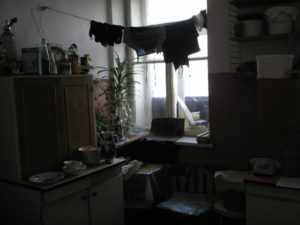
The kitchen was a meeting place where decisions concerning all inhabitants of the apartment would be made. People had to manage communal living, which required shared responsibilities and reliance on one another. Duty schedules were posted in the kitchen or corridors. The family on duty would be responsible for cleaning the common spaces.
Eventually communal apartments were declared ideologically outdated, and a special programme under the slogan “A separate apartment for each family” was launched by Nikita Khrushchev. Communal apartments strongly impacted people, with generations growing up in a very specific, controlled world, where private space was reduced to a minimum. Even today there remains a significant amount of communal apartments in St. Petersburg.[/vc_column_text][/vc_accordion_tab][/vc_accordion][/vc_column][/vc_row][vc_row][vc_column][vc_accordion active_tab=»1″ title=»Facts about Moscow»][vc_accordion_tab title=»Names of Moscow»][vc_column_text]
There are several versions of why our current capital is called “Moskva” – the Russian name of Moscow.
Most historians believe that the city received its name from the river flowing through it. The word “Moscow” is a Finno-Ugric word, and it came to us from the ancient times, when there were Finno-Ugric tribes living on the river’s banks. “Mosk” means either a cow or dark (not known for sure) and “wa” means water.
Another theory is that the name of the river is translated from Old Slavonic and means “swamp” or “dampness”.
There is also a Biblical version of the name’s origin: Mosokh, grandson of Noah, lived on the shore of the river. The river was named in honor of Mosokh and his wife Kwa.
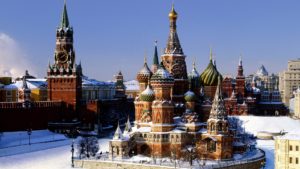
Moscow has many nicknames.
Moscow White-stone – because medieval Moscow was built of white stone.
Moscow – the city on 7 hills – because it is located on 7 hills (an analogue to Rome). However, currently Moscow is located on 8 hills.
Moscow Golden-Domed – because Moscow is the home to thousands of churches, convents, chapels and mosques, whose cupolas are covered with gold.
Moscow – Third Rome – because in the Middle Ages it was believed that Moscow was a successor of the Roman Empire (the “first Rome”) and the Byzantine Empire (the “second Rome”).
Moscow – port of 5 seas – because of the Moscow Canal, Moscow has access to five seas: the White Sea, Baltic Sea, Caspian Sea, Azov Sea, and the Black Sea.[/vc_column_text][/vc_accordion_tab][vc_accordion_tab title=»Metro»][vc_column_text]
Moscow has the largest metro in Europe (333, 5 km) and the 5th longest in the world. It has 13 lines and 200 stations (44 are considered as objects of historical significance).
The first construction projects of Moscow metro date back to 1890. The Moscow metro had its first riders on May 15, 1935 (red line – Sokolniki – Park Kultury). The metro station was supposed to be located on Red Square, on the place where Lenin’s Mausoleum is currently located.
During World War II, the Moscow Metropolitan (Metro) was actively used as a bomb shelter, and after the Second World War new metro stations were constructed as a defense shelters (even against nuclear strike) in case somebody would attack Soviet Union.
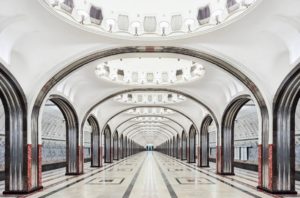
Since its opening, Metro did not run only once – on October 16, 1941. The Germans came very close to the Metro, planning to destroy it. However, by the end of that day the Metro got back on track.
Nowadays, more than 7 million people use the Metro every day. The average speed of trains is 41.61 km / h. The interval in the movement of trains in rush hour is 90 seconds. On purple, orange, green and grey lines a typical train consists of eight cars, on blue and brown – of six, on the other lines – seven.
The Pechatniki metro station is the closest to the surface of the earth – just 5 m deep.
The longest line is dark blue, Arbat-Pokrovskaya, with the length of 45.1 km.
The shortest line is Kakhovskaya – only 3.3 km long with only 3 stops.
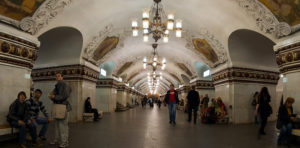
The deepest station, Park Pobedy, at 84 meters deep is one of the deepest stations in the world. Also, it has the longest escalator (126 meters).
There are 76 bronze figures portraying Soviet heroes on the platform of Revolution Square station. ‘The border guard with a dog” is a favorite among students – they believe that if you rub the nose of the dog, the exam will be passed successfully.
There is a legend of a secret branch of the Metro, the so-called Metro-2. The Metro-2 allegedly has a passage in the Kremlin, and access through the corridors and offices of the red line of the Metro. Metro-2 is supposedly equipped with everything military and government personnel may require, from food storage to the nuclear button.[/vc_column_text][/vc_accordion_tab][vc_accordion_tab title=»7 sisters»][vc_column_text]
In Moscow there are 7 similarly styled, tall buildings: 2 hotels, 2 office buildings, 2 houses and a university. They are the Stalin skyscrapers, also named the Seven Sisters (but you should know that locals won`t understand the term 7 Sisters; it is better to say “vysotki” – skyscraper.)
The 7 sisters were built in a specially created combination of different architectural solutions, the style which was later named Soviet Monumental Classicism or Stalinist Empire Style.
The Seven Sisters are:
Moscow State University (the Main Building, 240 m). It was the tallest building in Europe until 1990.
Hotel Ukraina (Radisson Royal Hotel) – 198 m. It was the highest hotel in the word till the Peachtree Plaza Hotel opened in Atlanta in 1975. The hotel was reopened after renovation on April 28, 2010, now called Radisson Royal Hotel. 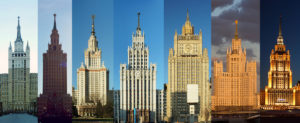
Ministry of Foreign Affairs – 172 m. A huge emblem of USSR is located on the façade. Originally, the creators did not include the spire, but eventually the project was modified. The Ministry is the only vysotki not having a pentagonal star on its spire.
Hilton Moscow Leningradskaya Hotel – 136 m. It is decorated with pseudo-Russian ornaments mimicking Kazansky railway station. Some years ago Leningradskaya was bought by Hilton.
Kudrinskaya Square Building (skyscraper on Rebellion Square) – 156 m. It was primary built as apartments for Soviet cultural leaders. The apartments now belong to commercial firms.
Kotelnicheskaya Embankment Building – 176 m. After the War, the building was converted to Kommunalka (communal apartments). Now there are flats, shops, post-office, and a museum.
Red Gates Administrative Building – 133 m. The construction of the tower was complicated by its location near the Metro. Architect built a second entrance to the station into the ground floor of the tower.
There supposed to be 2 more skyscrapers – Zaryadie Administrative Building and Palace of Soviets, which were never built.
[/vc_column_text][/vc_accordion_tab][vc_accordion_tab title=»Arbat street»][vc_column_text]The word “Arbat” is Arabic and it means “the suburbs”.
In the 15 century the whole area from the Kremlin to the Garden Ring was called Arbat. The main street, presently called Old Arbat, is one of the oldest streets in Moscow. It runs from from East to West and in the past, housed many foreign embassies. It was also was a key route for military access to and from the center of Moscow.
During the reign of Ivan the Terrible, his bodyguards, the notorious Oprichnina, had their headquarters in the Arbat.
Then, during the Napoleon invasion (1812), Arbat was burnt to ashes.
After the war, Arbat Street was rebuilt.
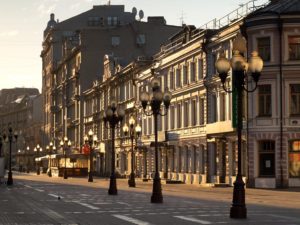
More than 500 artists, actors, musicians, and poets have lived on this street (for example, Russian poet Alexander Pushkin rented a flat here).
The first trolley bus ran on Arbat Street, but after an underground bunker was built, it was decided to make the street pedestrian only because it could collapse otherwise.
After the demise of the USSR, Arbat Street was often a gathering place for informal youth movements like hippies or punks. Artists and musicians also gathered there.
Note: There is no wind in this street because of a peculiar way the Vakhtangov Theatre on Arbat was constructed.
Today Arbat Street, which has numerous restaurants and souvenir shops, has become a popular tourist destination.
There is also the New Arbat Street, a 6-lane thoroughfare constructed in the 1960s that carries traffic from Arbat Square to Novoarbatsky Bridge.[/vc_column_text][/vc_accordion_tab][/vc_accordion][/vc_column][/vc_row]